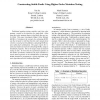Free Online Productivity Tools
i2Speak
i2Symbol
i2OCR
iTex2Img
iWeb2Print
iWeb2Shot
i2Type
iPdf2Split
iPdf2Merge
i2Bopomofo
i2Arabic
i2Style
i2Image
i2PDF
iLatex2Rtf
Sci2ools
SCAM
2008
IEEE
2008
IEEE
Constructing Subtle Faults Using Higher Order Mutation Testing
Traditional mutation testing considers only first order mutants, created by the injection of a single fault. Often these first order mutants denote trivial faults that are easily killed. This paper investigates Higher Order Mutants (HOMs). It introduces the concept of a subsuming HOM; one that is harder to kill than the first order mutants from which it is constructed. By definition, subsuming HOMs denote subtle fault combinations. The paper reports the results of an empirical study into subsuming HOMs, using six benchmark programs. This is the largest study of mutation testing to date. To overcome the exponential explosion in the number of mutants considered, the paper introduces a search based approach to the identification of subsuming HOMs. Results are presented for a greedy algorithm, a genetic algorithm and a hill climbing algorithm.
Mutation Testing | SCAM 2008 | Software Engineering | Traditional Mutation Testing | first Order Mutants |
| Added | 01 Jun 2010 |
| Updated | 01 Jun 2010 |
| Type | Conference |
| Year | 2008 |
| Where | SCAM |
| Authors | Yue Jia, Mark Harman |
Comments (0)

